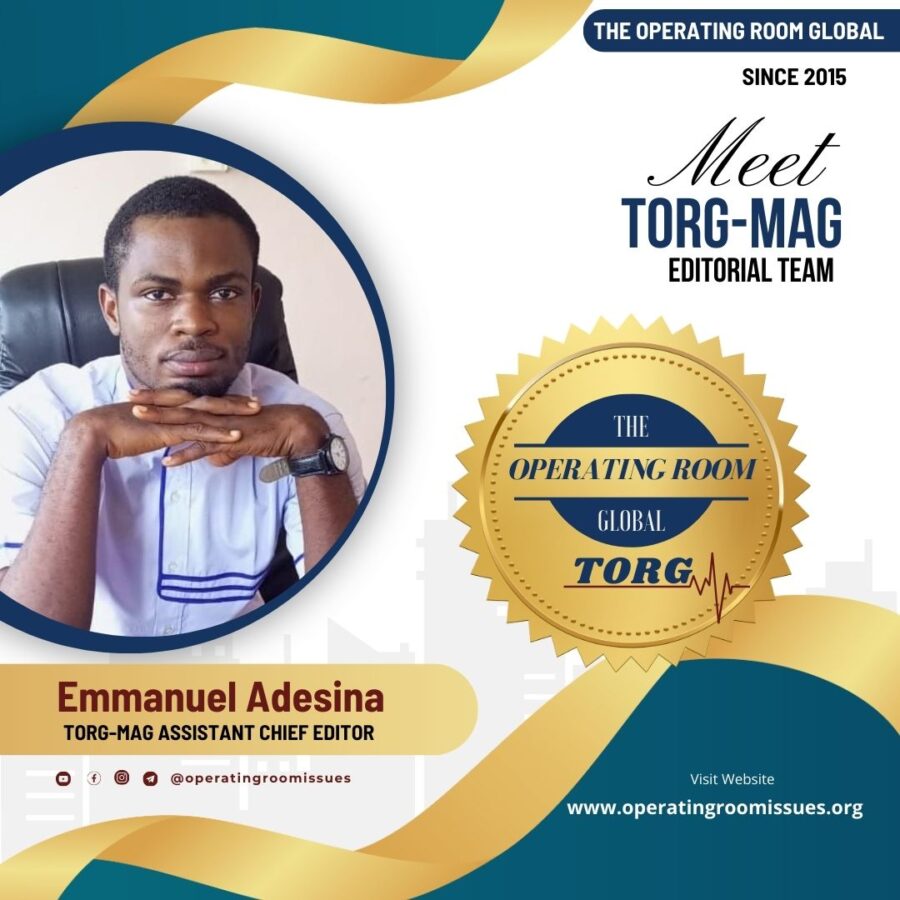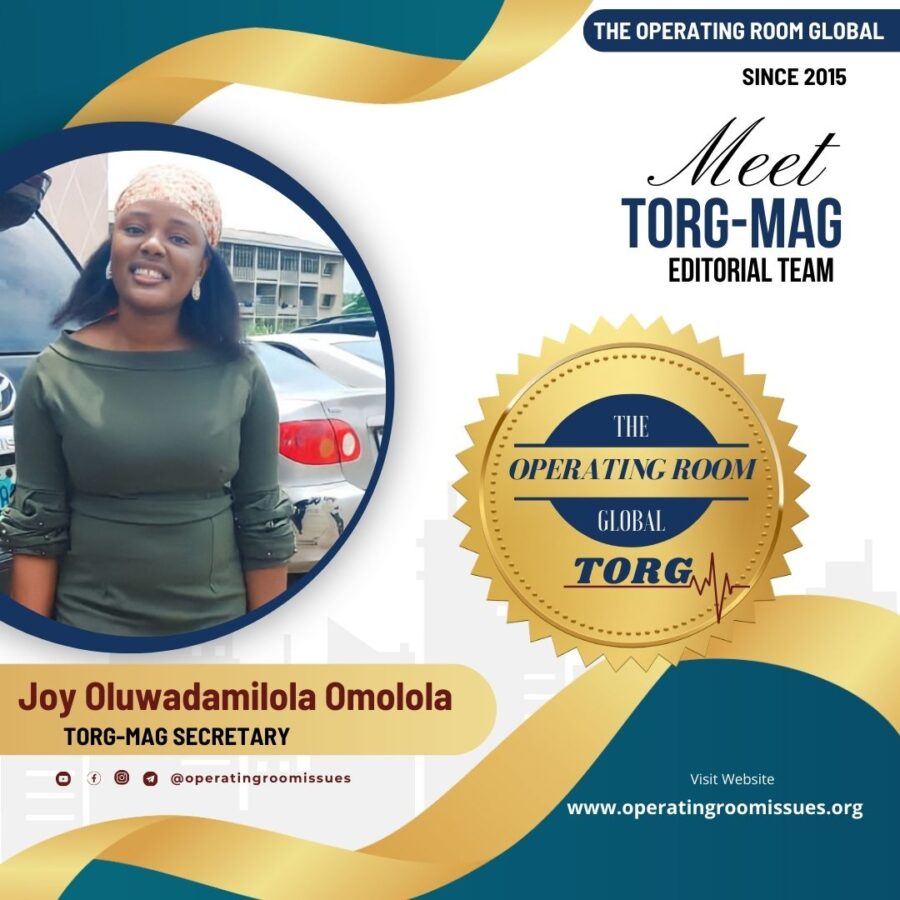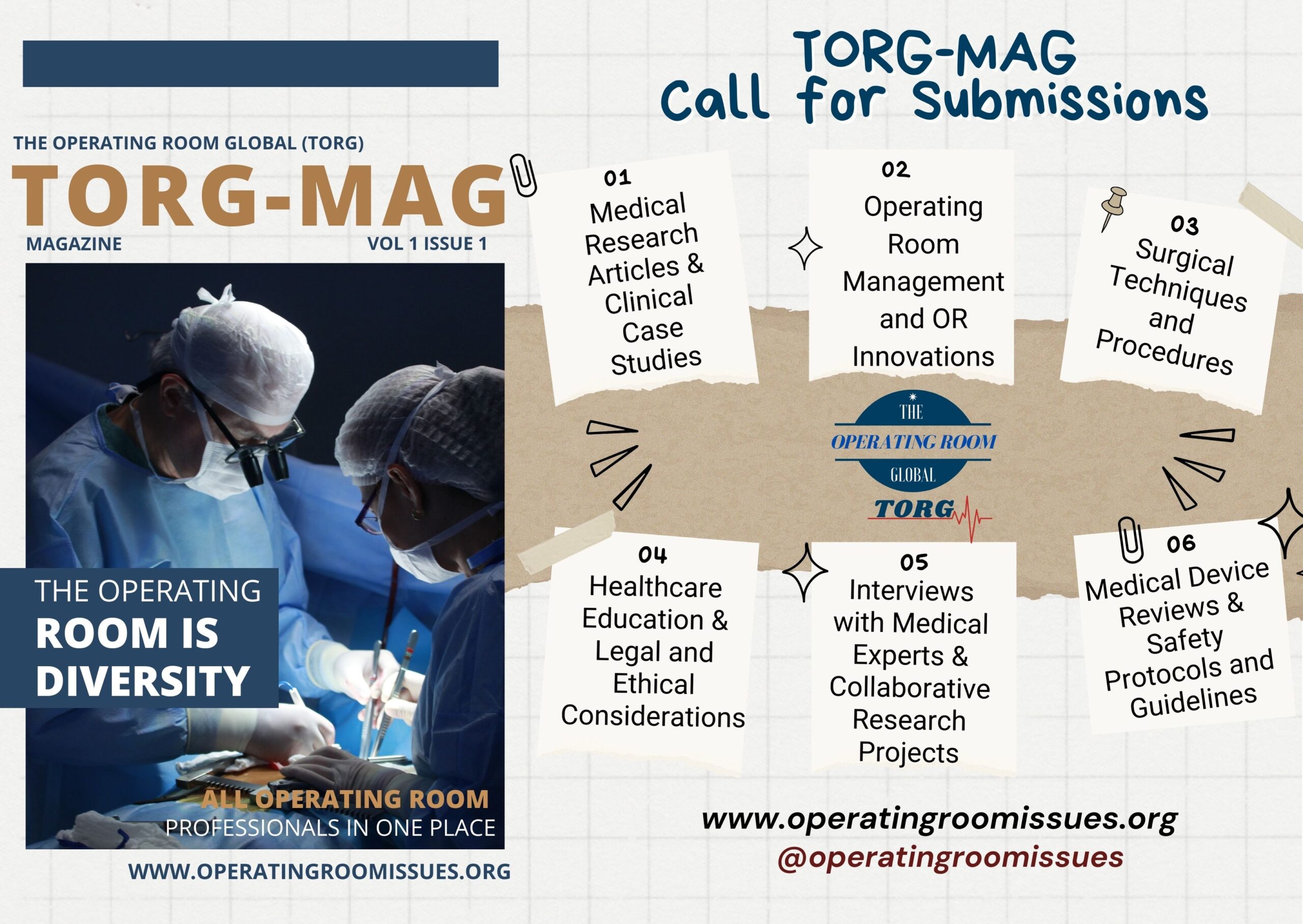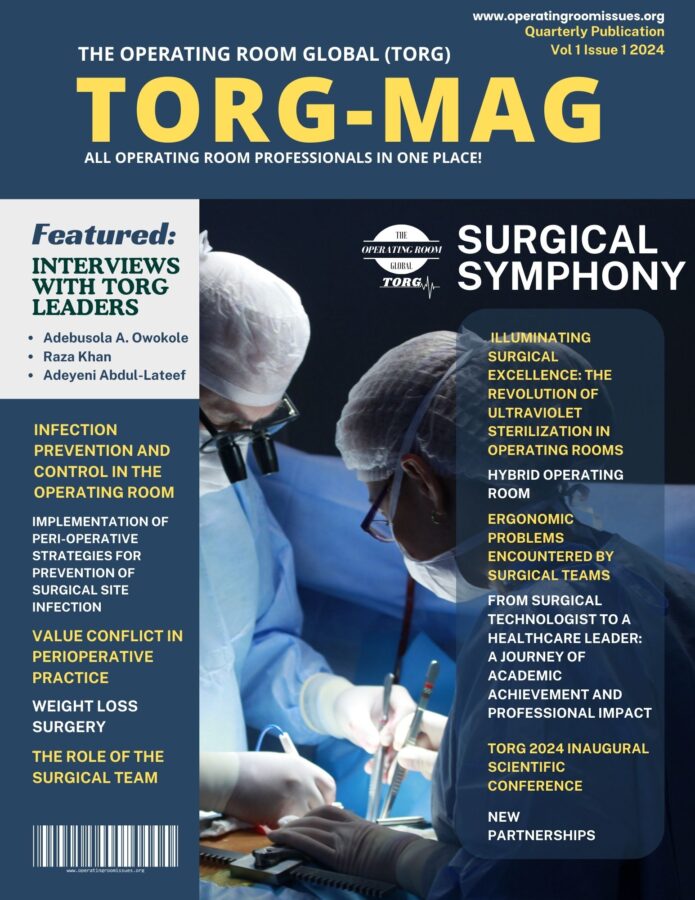
Get ready for the official launch of the maiden edition of TORG-MAG, our Quarterly Publication! This maiden publication, tagged ‘Surgical Symphony’, is dedicated to addressing critical issues in the operating room setting. Join us for the grand launch at the upcoming TORG-2024 Inaugural Scientific Conference in Lagos, Nigeria (August 7-9th 2024)! Click here to save the dates and reserve your seat!
The Operating Room Global (TORG) Magazine (TORG-MAG) is excited to announce our latest call for submissions, inviting all passionate individuals within the operating room community to share their insights and expertise.
Are you a surgeon, anesthesiologist, nurse, or healthcare professional with a unique perspective to offer? TORG-MAG is your platform to showcase your knowledge and experiences. Join us in fostering collaboration and innovation in the operating room. We invite submissions on surgical techniques, patient stories, innovative technologies, and more, all aimed at enhancing surgical practice and patient care. Your contribution could be the key to inspiring and educating others in the field. Don’t miss the opportunity to be a part of TORG-MAG’s mission to advance operating room practices. Submit your articles, case studies, and insights today to TORG-MAG, where your voice can make a meaningful impact on the future of surgical excellence. Together, we can elevate the art and science of the operating room.
What can you submit?
Medical Research Articles: Articles that delve into the latest advancements, research findings, and innovations in the field of surgery, anesthesia, and operating room procedures.
Clinical Case Studies: In-depth analyses of unique or challenging surgical cases, highlighting the surgical techniques, patient outcomes, and lessons learned.
Surgical Techniques and Procedures: Explorations of surgical methods, tools, and technologies, providing insights into best practices and advancements in the operating room.
Healthcare Education: Articles and resources that enhance the knowledge and skills of medical professionals, including surgical teams, through training modules, guidelines, and educational content.
Patient Stories: Personal narratives or testimonials from patients who have undergone surgical procedures, showcasing their experiences.
Interviews with Medical Experts: Conversations with surgeons, anesthesiologists, nurses, and other healthcare professionals who are at the forefront of operating room practices.
Medical Device Reviews: Evaluations and reviews of surgical equipment, instruments, and technologies that are relevant to operating room settings.
Safety Protocols and Guidelines: Articles discussing safety measures, protocols, and best practices for maintaining a safe operating room environment.
Operating Room Management: Insights into the efficient management and organization of operating rooms, including staff coordination and resource allocation.
Operating Room Innovations: Reports on new technologies, procedures, or approaches that improve the efficiency and outcomes of surgical interventions.
Legal and Ethical Considerations: Discussions on the legal and ethical aspects of surgical procedures, including informed consent, patient rights, and medical ethics.
Collaborative Research Projects: Updates on collaborative research initiatives involving multiple healthcare disciplines aimed at improving operating room practices.
WRITTEN ARTICLES
Please submit your written articles in a format that can be read by Microsoft Word. Feel free to include a cover letter, but they are not necessary. Please do include a short bio. We do consider previously published work, but would prefer new and original work. Simultaneous submissions are welcome and encouraged, but if your work is accepted elsewhere, please let us know immediately. All texts must be submitted in English. Authors not fluent in English should write in their native language and then have the text professionally translated before submitting it.
| Disciplines | Topics |
| Surgery | Acute Care Surgery Surgical Oncology And Endocrine Surgery Colon & Rectal Surgery Transplant And Hepatobiliary Surgery Minimal Invasive And Bariatric Surgery Surgical Critical Care Surgical Techniques And Procedures Post-Operative Care Prophylactic Surgery Diversity Robotic Surgery. |
| Anesthesiology | Ambulatory Anesthesiology Anesthesiology Critical Care Medicine Cardio Thoracic Medicine Multi-Specialty Adult Anesthesiology Neuro Anesthesiology, Pain Medicine Pediatric Anesthesiology Pediatric Cardiac Anesthesiology Veterans Affair Anesthesiology Pre-Operative Evaluation in Anesthesia |
| Theatre and Perioperative Nursing | Perioperative Nurse Robotic Surgery Experience Technology Stress in Perioperative Nursing Inter Professional Team Work Influences in Perioperative Nursing Communication in A Multicultural Operating Theatre Perception Of Caring In Perioperative Nursing Value Conflicts in Peri-Operative Practice Responsibility of Patient Care in Peri-Operative Practice Auditing in Operating Room Recycling Equity Inclusivity and Belonging Among O.R Professionals Professional Socialization |
| Scrub, Circulatory and Recovery staff | Radiation Exposure Among Scrubs and Circulatory Staff Staffing for Safety in Operation Theater Surgical Team Mapping Staff Orientation and Collaboration Challenges In Perioperative Education Preventive Strategies for Retained Surgical Items Operation Theater Scheduling with Patient Recovery Patient Temperature Audit in Theater Recovery Noise Pollution in Anesthetic and Intensive Care Unit. |
| Anesthesia nurse, Anesthesia technicians | Operating Room Efficacy Indicators Operating Room Efficiency Over Utilized Operating Room Time Precautions for Operating Room Team Members Inter-Professional Team Work in the Operating Theatre Job Burnout and Associated Factors. |
| Certified Surgical technologists , Central sterile processing | Infection Prevention and Control Ultra Violet Sterilization Robot Greening In the Operating Room Multiple Operating Room Scheduling and Sterilization Schedules of Reusable Items Bio Aerosols After Disinfection and Sterilization Methods of Sterilization, Storage of Sterilized Items Reasons of Wet Packs After Steam Sterilization Musculoskeletal Disorders Among Surgical Technologists Surgical Technologist in Circulatory And Scrub Roles Sustainability Initiatives in Operating Rooms Evacuation Of Smoke in Operating Room Team Resource Management. |
| Medical device management | Noise Reduction of Medical Devices Communication Devices in Operating Rooms Medical Device Adaptation for Digital Operating Rooms Automated Medical Technology Safety Oriented Architecture for Safety and Dynamics of Medical Devices Ergonomic Problems Encountered by Surgical Team in Minimal Invasive Surgery Optimize Waste Streams in Operating Rooms. |
| Perfusion Medicine | Quality Assurance in Perfusion: Ensuring the Best Patient Care Innovative Strategies for Blood Management and Transfusion in Perfusion Practice Pediatric Perfusion: Unique Challenges and Techniques Perfusion Education and Training: Preparing the Next Generation of Specialists Ethical Considerations in Perfusion. |
| Research articles | Collaborative or Individual Reasearch Projects Clinical Case Studies Articles that delve into the latest advancements, research findings, and innovations in the field of surgery, anesthesia, and operating room procedures. |
By submitting, you verify that you are the Author of the submitted work, and that the Author grants Rights to TORG-MAG for publication. Rights revert to the Author upon publication.
All images included in the submission article are the responsibility of the Author. It is the Author’s responsibility to ensure that any images used their submissions do not break international copyright law.
Please credit the TORG-MAG as place of first publication. TORG-MAG reserves the right to make minor copy editing changes to the manuscript. Any major editorial changes will require author’s approval prior to publication. TORG-MAG will be published on ResearchGate with a DOI issued for referencing and all who contributed to the Mag will be notified to confirm authorship so it can appear on their personal research profile.
ABSTRACT
Each written article requires an abstract written in the third person, summarizing the article’s main point; maximum 100 words.
📢Click Here to Join the TORG-MAG Editorial Team – Calling All Operating Room Enthusiasts! 🏥
FORMATTING THE WRITTEN ARTICLE
The article should be prepared according to the following guidelines:
(1) The ideal length of a feature article is either circa 750 words (one page) or circa 1,400 words (two pages). However in some circumstances other lengths may be accommodated. Generally, no greater than 5,000 words but should not exceed 7,000 words, including an abstract and notes. An article exceeding the length limit will be returned to the author.
(2) At the beginning of the article, the title, abstract and a list of key words should immediately precede the text.
(3) All citations should be in endnotes and not in the text. Number endnotes sequentially with Arabic numbers. Use the endnote function in your word processing program so that the notes appear at the end of the article.
In endnotes, references are placed at the end of the document or chapter, rather than at the bottom of each page.
Example of citing a book in endnotes:
- Author’s First Name Last Name, Title of Book (Place of Publication: Publisher, Year), Page Number.Example:
- John A. Smith, The History of Time (New York: Academic Press, 2000), 45.
Example of citing a journal article in endnotes:
- Author’s First Name Last Name, “Title of Article,” Title of Journal Volume Number, no. Issue Number (Year): Page Range.Example:
- Mary K. Johnson, “The Impact of Climate Change on Biodiversity,” Environmental Science 25, no. 3 (2015): 123-145.
(4) Font should be 11-point Arial, whether in normal, bold, or italic, including endnotes. Please do not insert line breaks in the text or special spacing for formatting.
(5) The paragraph break should be indicated by an extra line space rather than an indentation at the beginning of a paragraph.
(6) Only the left hand margin should be justified.
ACCEPTABLE FILE TYPES
- Please submit texts in MS Word or Rich Text Format (RTF). If submitting from a Macintosh computer, please include the three-letter file extension in the file name of your article. PDF files are not acceptable.
- Images should be in .jpg or .tif format.
- Naming files: File names should not contain spaces. They may contain letters, numbers, hyphens (-) and underscores (_). No other punctuation is allowed. Files must have the three-letter file extension identifying the file type (i.e. .rtf, .wpd, .doc), whether submitted from a Windows or Macintosh computer.
- AppleWorks, Lotus, or other word processor documents must be saved in one of the above formats.
ILLUSTRATION GUIDELINES
- Illustrations are encouraged for all articles (if relevant) and should be provided as high-resolution jpg digital images.
- Lettering on diagrams must be professional quality.
- A list of figure captions should be included with each illustrated manuscript and must include credits to the copyright holder and/or photographer.
- Authors have full responsibility for providing visual material that suitably complements their articles and meets the professional requirements of TORG-MAG. The editorial office does not provide graphic services. Careful attention to these guidelines should assure authors of visually effective articles.
CREDITS AND COPYRIGHT PERMISSION
Captions to images used in all articles must also include credits to photographers and artwork owners and, in the case of copyrighted material, the names of copyright holders. Authors are responsible for securing permissions to reprint copyrighted material and must supply original, signed documentation of this permission from the copyright holder(s) and photographers to the editorial office before material can be published. Any fees required to secure copyright permissions or use of figures are the responsibility of authors.
ARTISTS’ WRITINGS and VISUAL ARTICLES
Since one of the Interalia Magazine’s primary purposes is to encourage artists to discuss their work, artists are invited to submit illustrated texts dealing with their current work or a body of work that has been carried out over an extended period. These texts should be written in the artist’s voice, although they may be written with a co-author. Articles of 2000 to 3000 words in length (including endnotes) may have up to 12 colour or black-and-white illustrations. Articles under 2000 words in length (including endnotes) may have up to 6 colour or black-and-white illustrations.
‘Visual’ articles, requiring no text, may have up to 20 colour or black-and-white images.
SUBMITTING AN ARTICLE
An email message with the article as an attachment for TORG-MAG should be sent to torgmag@operatingroomissues.org
Use “Submission” as the subject in the email address block. The message should include (1) the author’s name, (2) the title of the article, (3) an abstract of no more than 150 words, and (4) any relevant information about the author, including institutional affiliation, mailing and e-mail addresses.
Once you have prepared your paper observing the formatting, attach it to the e-mail message. An acknowledgement will be sent indicating that the paper has been received within 3 working days.
We do our best to respond to acceptance for publication of submissions within two months maximum. We are unable to respond to inquiries about the status of submissions. This is especially true for phone calls. We appreciate your patience!
COPYRIGHT
Articles published in TORG-MAG remain in the copyright of the author. Copyrights to illustrations published in the TORG-MAG remain with their current copyright holders. The author’s written permission to publish both text and images must be received at the TORG-MAG editorial office before any manuscript will be edited in preparation for publication. In cases where an image is copyrighted by a third party, authors are responsible for obtaining copyright permissions, including on-line reproduction rights. Any fees required to obtain illustrations or to secure copyright permissions are the responsibility of authors.
Permission to re-use material published in the TORG-MAG is given to the authors of articles for use in their own publications. Use by third parties generally is not provided without concurrence of the author.
DISCLAIMER
Statements of fact and opinion in the articles in TORG-MAG are those of the respective authors and contributors and not of the editors of TORG-MAG. No representation, express or implied, is made of the accuracy of the material in TORG-MAG. TORG-MAG and The Operating Room Global (TORG) cannot accept any legal responsibility or liability for any errors or omissions that may be made. The reader should make his or her own evaluation of the accuracy and appropriateness of those materials.
📢Click Here to Join the TORG-MAG Editorial Team – Calling All Operating Room Enthusiasts! 🏥
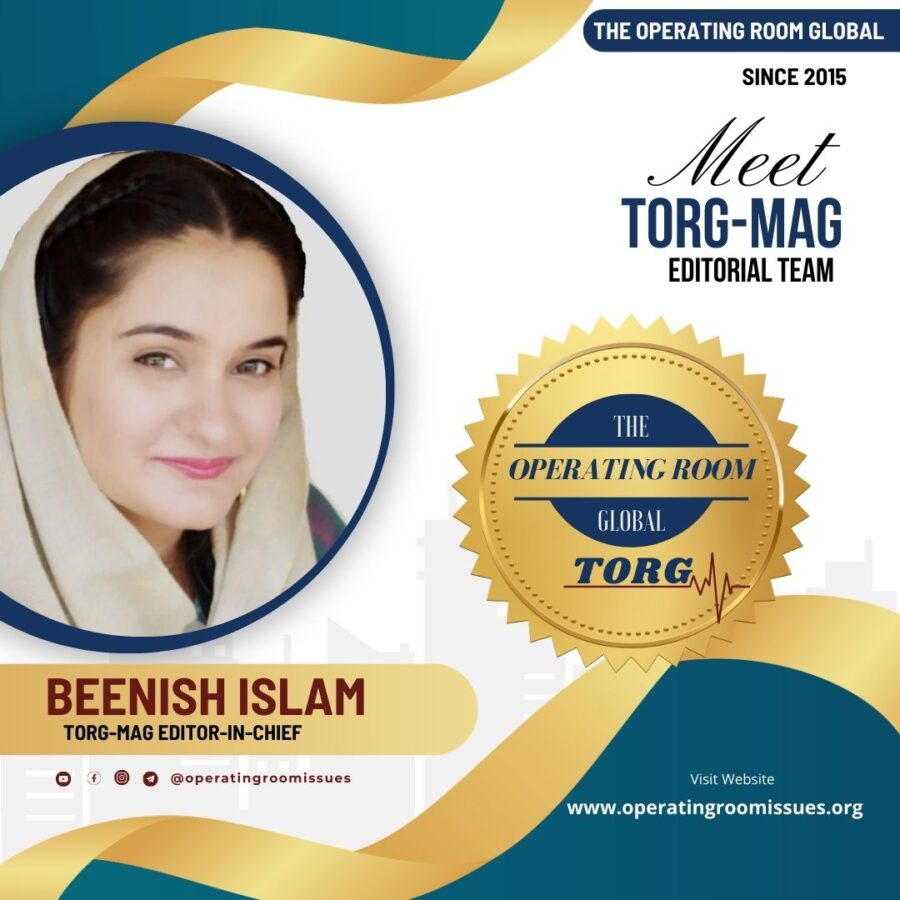
Meet Beenish Islam: TORG-MAG Editor-In-Chief
We are delighted to introduce Beenish Islam, as the Editor-in-Chief of TORG-MAG, the official publication of The Operating Room Global (TORG). Her background and expertise are truly impressive, and we believe she will be an invaluable addition to our team. With over a decade of experience in this domain, she has consistently demonstrated her commitment to advancing surgical care and healthcare education.. Click Here to Read More
